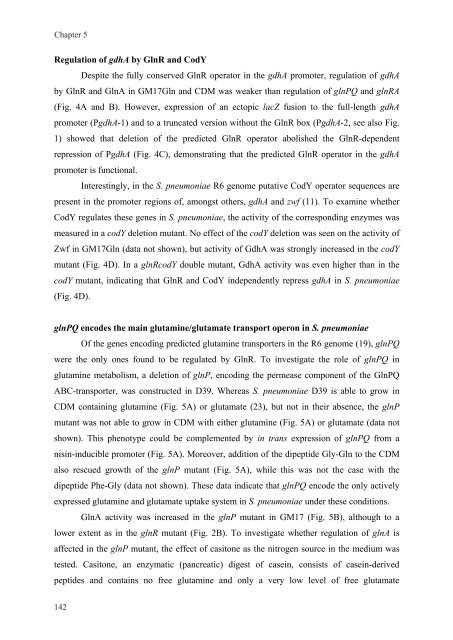Gene regulation in Streptococcus pneumoniae - RePub - Erasmus ...
Gene regulation in Streptococcus pneumoniae - RePub - Erasmus ...
Gene regulation in Streptococcus pneumoniae - RePub - Erasmus ...
You also want an ePaper? Increase the reach of your titles
YUMPU automatically turns print PDFs into web optimized ePapers that Google loves.
Chapter 5<br />
Regulation of gdhA by GlnR and CodY<br />
142<br />
142<br />
Despite the fully conserved GlnR operator <strong>in</strong> the gdhA promoter, <strong>regulation</strong> of gdhA<br />
by GlnR and GlnA <strong>in</strong> GM17Gln and CDM was weaker than <strong>regulation</strong> of glnPQ and glnRA<br />
(Fig. 4A and B). However, expression of an ectopic lacZ fusion to the full-length gdhA<br />
promoter (PgdhA-1) and to a truncated version without the GlnR box (PgdhA-2, see also Fig.<br />
1) showed that deletion of the predicted GlnR operator abolished the GlnR-dependent<br />
repression of PgdhA (Fig. 4C), demonstrat<strong>in</strong>g that the predicted GlnR operator <strong>in</strong> the gdhA<br />
promoter is functional.<br />
Interest<strong>in</strong>gly, <strong>in</strong> the S. <strong>pneumoniae</strong> R6 genome putative CodY operator sequences are<br />
present <strong>in</strong> the promoter regions of, amongst others, gdhA and zwf (11). To exam<strong>in</strong>e whether<br />
CodY regulates these genes <strong>in</strong> S. <strong>pneumoniae</strong>, the activity of the correspond<strong>in</strong>g enzymes was<br />
measured <strong>in</strong> a codY deletion mutant. No effect of the codY deletion was seen on the activity of<br />
Zwf <strong>in</strong> GM17Gln (data not shown), but activity of GdhA was strongly <strong>in</strong>creased <strong>in</strong> the codY<br />
mutant (Fig. 4D). In a glnRcodY double mutant, GdhA activity was even higher than <strong>in</strong> the<br />
codY mutant, <strong>in</strong>dicat<strong>in</strong>g that GlnR and CodY <strong>in</strong>dependently repress gdhA <strong>in</strong> S. <strong>pneumoniae</strong><br />
(Fig. 4D).<br />
glnPQ encodes the ma<strong>in</strong> glutam<strong>in</strong>e/glutamate transport operon <strong>in</strong> S. <strong>pneumoniae</strong><br />
Of the genes encod<strong>in</strong>g predicted glutam<strong>in</strong>e transporters <strong>in</strong> the R6 genome (19), glnPQ<br />
were the only ones found to be regulated by GlnR. To <strong>in</strong>vestigate the role of glnPQ <strong>in</strong><br />
glutam<strong>in</strong>e metabolism, a deletion of glnP, encod<strong>in</strong>g the permease component of the GlnPQ<br />
ABC-transporter, was constructed <strong>in</strong> D39. Whereas S. <strong>pneumoniae</strong> D39 is able to grow <strong>in</strong><br />
CDM conta<strong>in</strong><strong>in</strong>g glutam<strong>in</strong>e (Fig. 5A) or glutamate (23), but not <strong>in</strong> their absence, the glnP<br />
mutant was not able to grow <strong>in</strong> CDM with either glutam<strong>in</strong>e (Fig. 5A) or glutamate (data not<br />
shown). This phenotype could be complemented by <strong>in</strong> trans expression of glnPQ from a<br />
nis<strong>in</strong>-<strong>in</strong>ducible promoter (Fig. 5A). Moreover, addition of the dipeptide Gly-Gln to the CDM<br />
also rescued growth of the glnP mutant (Fig. 5A), while this was not the case with the<br />
dipeptide Phe-Gly (data not shown). These data <strong>in</strong>dicate that glnPQ encode the only actively<br />
expressed glutam<strong>in</strong>e and glutamate uptake system <strong>in</strong> S. <strong>pneumoniae</strong> under these conditions.<br />
GlnA activity was <strong>in</strong>creased <strong>in</strong> the glnP mutant <strong>in</strong> GM17 (Fig. 5B), although to a<br />
lower extent as <strong>in</strong> the glnR mutant (Fig. 2B). To <strong>in</strong>vestigate whether <strong>regulation</strong> of glnA is<br />
affected <strong>in</strong> the glnP mutant, the effect of casitone as the nitrogen source <strong>in</strong> the medium was<br />
tested. Casitone, an enzymatic (pancreatic) digest of case<strong>in</strong>, consists of case<strong>in</strong>-derived<br />
peptides and conta<strong>in</strong>s no free glutam<strong>in</strong>e and only a very low level of free glutamate

















